人教版(2019)选择性必修第三册Unit 1 Art Reading and Thinking读思课课件(共22张PPT)
文档属性
| 名称 | 人教版(2019)选择性必修第三册Unit 1 Art Reading and Thinking读思课课件(共22张PPT) | 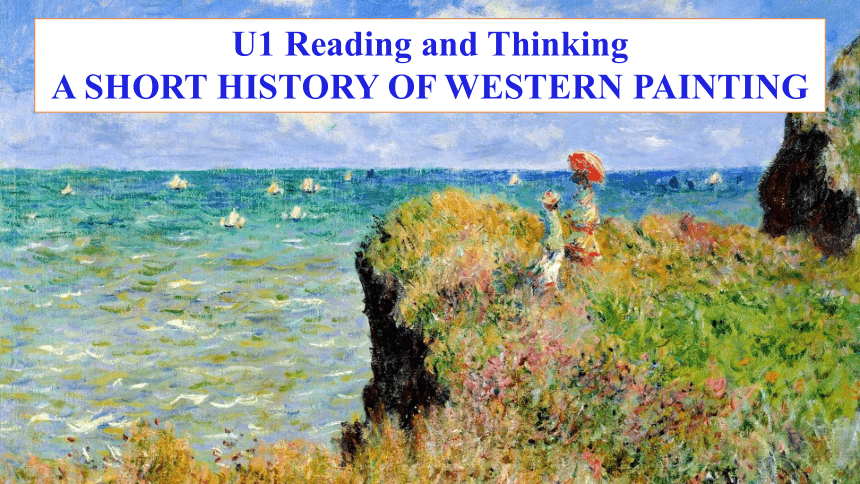 | |
| 格式 | pptx | ||
| 文件大小 | 6.6MB | ||
| 资源类型 | 教案 | ||
| 版本资源 | 人教版(2019) | ||
| 科目 | 英语 | ||
| 更新时间 | 2023-12-26 09:28:13 | ||
图片预览


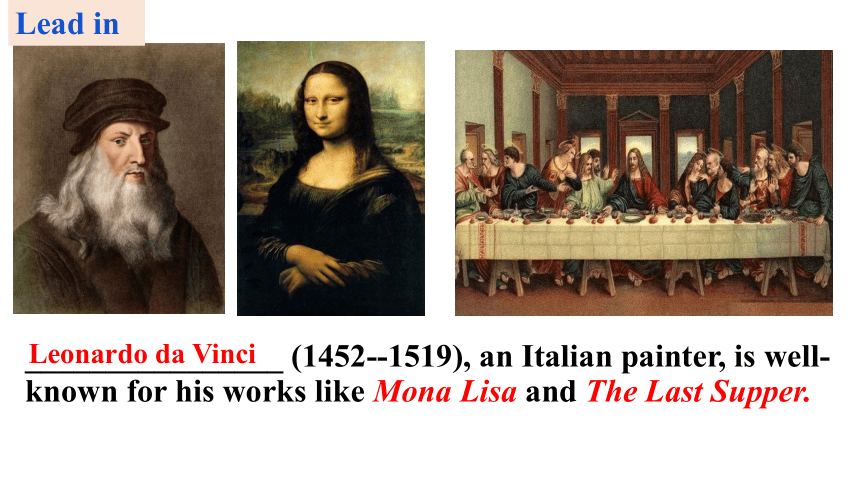
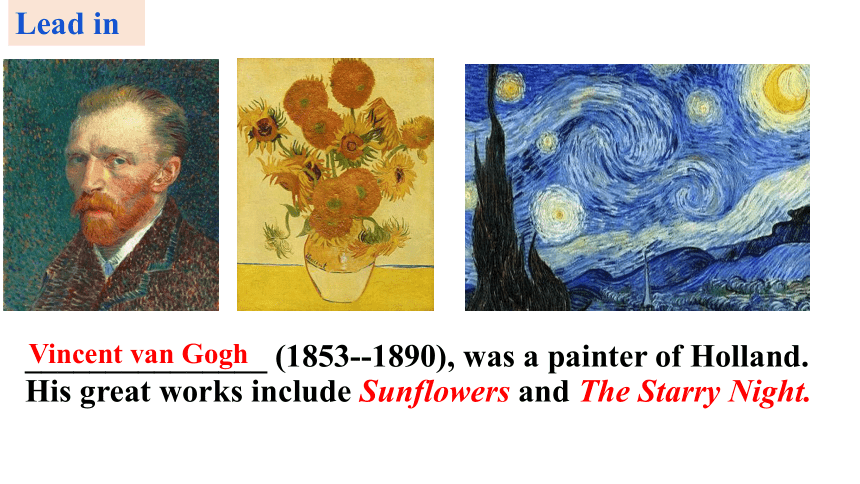
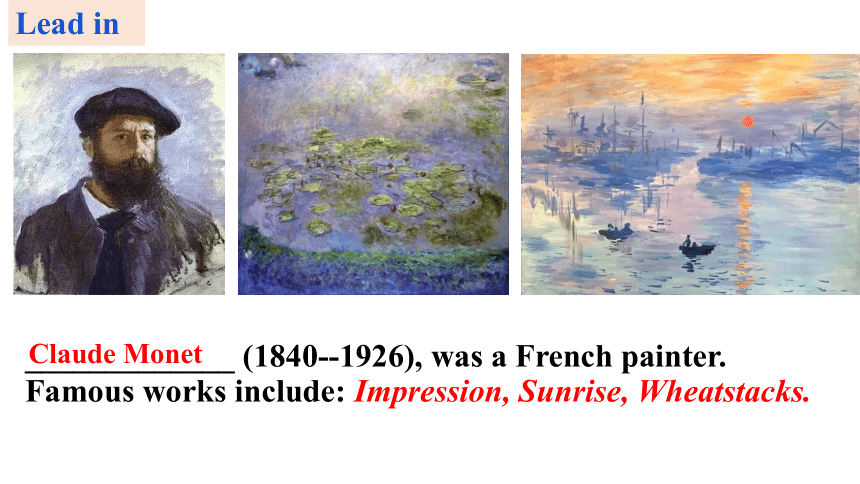
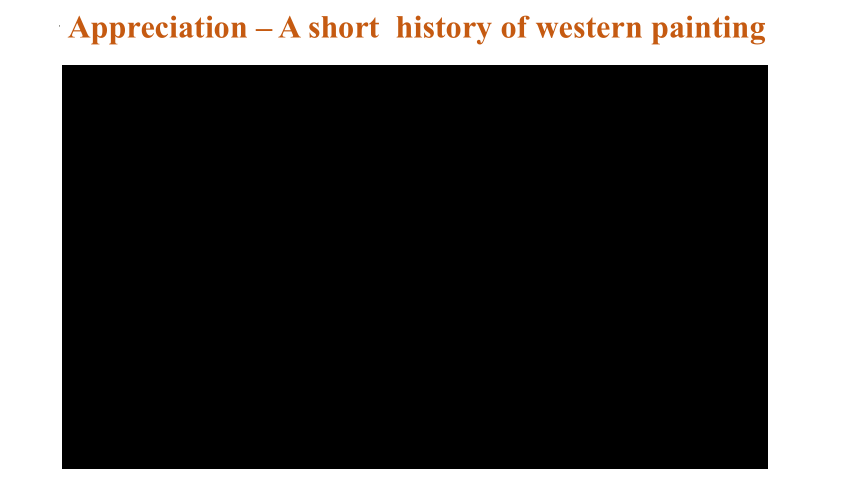
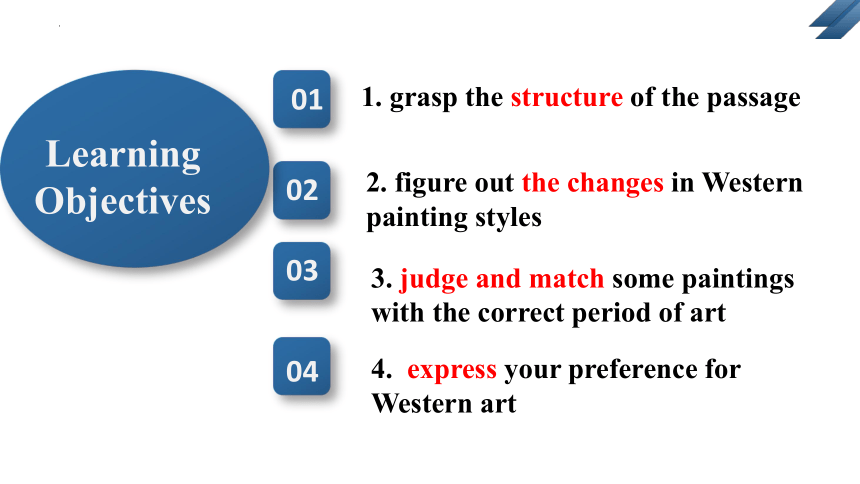
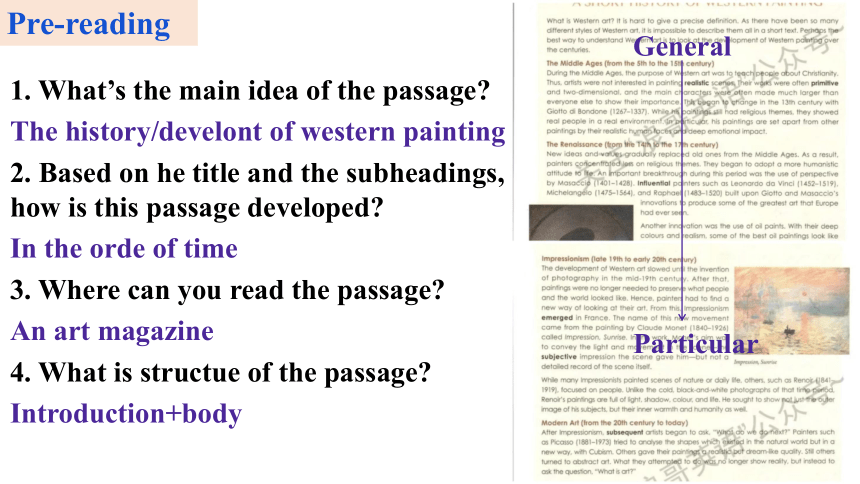
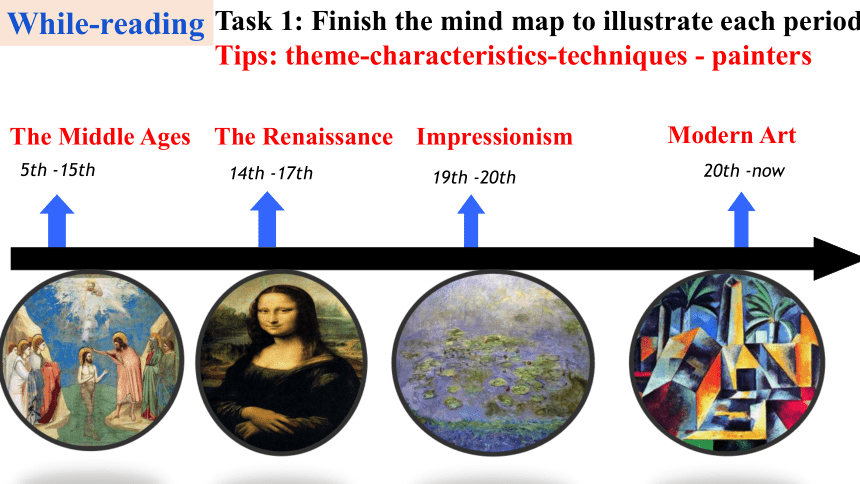
文档简介
(共22张PPT)
U1 Reading and Thinking
A SHORT HISTORY OF WESTERN PAINTING
Lead in
Art
calligraphy
dance
painting
architecture
sculpture
Why arts are so important
keep a record of the beauty in our life
a medium to communicate ideas
enrich our life
bring us spiritual pleasure and relieve stress
________________ (1452--1519), an Italian painter, is well-known for his works like Mona Lisa and The Last Supper.
Lead in
Leonardo da Vinci
_______________ (1853--1890), was a painter of Holland. His great works include Sunflowers and The Starry Night.
Lead in
Vincent van Gogh
_____________ (1840--1926), was a French painter.
Famous works include: Impression, Sunrise, Wheatstacks.
Lead in
Claude Monet
Appreciation – A short history of western painting
01
02
03
04
1. grasp the structure of the passage
Learning
Objectives
2. figure out the changes in Western painting styles
3. judge and match some paintings with the correct period of art
4. express your preference for Western art
Pre-reading
1. What’s the main idea of the passage
The history/develont of western painting
2. Based on he title and the subheadings, how is this passage developed
In the orde of time
3. Where can you read the passage
An art magazine
4. What is structue of the passage
Introduction+body
General
Particular
5th -15th
The Middle Ages
The Renaissance
Impressionism
Modern Art
14th -17th
19th -20th
20th -now
While-reading
Task 1: Finish the mind map to illustrate each period
Tips: theme-characteristics-techniques - painters
5th -15th
The Middle Ages
While-reading
theme: religion
characteristics :Not realistic
13th century: real people in real environment
Realistic human faces and deep emotional impact
Techniques:
primitive and two dimensional
painter(s):
Giotto di Bondone
Task 1: Finish the mind map to illustrate each period
Tips: theme-characteristics-techniques - painters
Techniques:
use of perspective
the use of oil pints
deep colors and realism
look like a photograph
The Renaissance
14th -17th
While-reading
Themes:
less religious
adopt a more humanistic attitude
Task 1: Finish the mind map to illustrate each period
Tips: theme-characteristics-techniques - painters
Painters:
Davinci, Michelangelo and Raphael
Appreciation
The Middle Ages
The Renaissance
Impressionism
19th -20th
While-reading
Themes: senses of nature or life
Aim:
to convey light and movement
subjective impression
not a detailed record of the scene
Techniques:
full of light, shadow, color and life
not only show the outer images of his subjects but also their inner warmth and humanity
Painters:
Claude Mone
Renoir
Task 1: Finish the mind map to illustrate each period
Tips: theme-characteristics-techniques - painters
Get a glimpse of Claude Monet
Modern Art
20th -now
While-reading
Theme&characteristics:
analyse the shape in a new way, with Cubism
Realistic but dream-like qualities
Abstract art:
attempt to ask the question, “What is art” rather than show reality
Painters:
Picasso
Task 1: Finish the mind map to illustrate each period
Tips: theme-characteristics-Abstract art - painters
While-reading
Task 2: Find out the purpose painting in each period
The Middle Ages
The Renaissance
Impressionism
Modern Art
spread religion
record or preserve
record or express
explore the nature of the art
not real
real
beyond real
ignorant
awakened
tolerant
Periods
purpose
Life or humanity
Post-reading
Task 1: A western painting show is on display. Suppose you are the
staff of the gallery. Work in groups and try to do an introduction
to the visitors. Each member introduce on section. You have 5 minutes to discuss.
Attention, please! This wonderful work belongs to _____________. This picture describes __________.
The theme of painting at that time was_____________.
Painters, such as ________, tried to____________
Post-reading
Task 2: Pragmatic analysis
What is the writing purpose of the passage
To inform readers of the short history of western painting.
2. Who are the intended readers
Readers interested in Western painting.
3. What is the author’s attitude
Neutral or objective.
Post-reading
Task 3: Critical thinking
2. Which period of Western art do you like most Why are you fond of it
Why have Western painting style been changing
Summary and Assessment
A short history of western painting
Are you able to
1. grasp the structure of the passage
2. figure out the changes in Western painting styles
3. judge and match some paintings with the correct period of art
4. express your preference for Western art
Greeting
Introducing the topic (signpost markers on page 7)
Body part (periods-characteristics-representatives)
Thank you for your listening
Homework
Write a short speech entitled “Western paintings” through the ages
U1 Reading and Thinking
A SHORT HISTORY OF WESTERN PAINTING
Lead in
Art
calligraphy
dance
painting
architecture
sculpture
Why arts are so important
keep a record of the beauty in our life
a medium to communicate ideas
enrich our life
bring us spiritual pleasure and relieve stress
________________ (1452--1519), an Italian painter, is well-known for his works like Mona Lisa and The Last Supper.
Lead in
Leonardo da Vinci
_______________ (1853--1890), was a painter of Holland. His great works include Sunflowers and The Starry Night.
Lead in
Vincent van Gogh
_____________ (1840--1926), was a French painter.
Famous works include: Impression, Sunrise, Wheatstacks.
Lead in
Claude Monet
Appreciation – A short history of western painting
01
02
03
04
1. grasp the structure of the passage
Learning
Objectives
2. figure out the changes in Western painting styles
3. judge and match some paintings with the correct period of art
4. express your preference for Western art
Pre-reading
1. What’s the main idea of the passage
The history/develont of western painting
2. Based on he title and the subheadings, how is this passage developed
In the orde of time
3. Where can you read the passage
An art magazine
4. What is structue of the passage
Introduction+body
General
Particular
5th -15th
The Middle Ages
The Renaissance
Impressionism
Modern Art
14th -17th
19th -20th
20th -now
While-reading
Task 1: Finish the mind map to illustrate each period
Tips: theme-characteristics-techniques - painters
5th -15th
The Middle Ages
While-reading
theme: religion
characteristics :Not realistic
13th century: real people in real environment
Realistic human faces and deep emotional impact
Techniques:
primitive and two dimensional
painter(s):
Giotto di Bondone
Task 1: Finish the mind map to illustrate each period
Tips: theme-characteristics-techniques - painters
Techniques:
use of perspective
the use of oil pints
deep colors and realism
look like a photograph
The Renaissance
14th -17th
While-reading
Themes:
less religious
adopt a more humanistic attitude
Task 1: Finish the mind map to illustrate each period
Tips: theme-characteristics-techniques - painters
Painters:
Davinci, Michelangelo and Raphael
Appreciation
The Middle Ages
The Renaissance
Impressionism
19th -20th
While-reading
Themes: senses of nature or life
Aim:
to convey light and movement
subjective impression
not a detailed record of the scene
Techniques:
full of light, shadow, color and life
not only show the outer images of his subjects but also their inner warmth and humanity
Painters:
Claude Mone
Renoir
Task 1: Finish the mind map to illustrate each period
Tips: theme-characteristics-techniques - painters
Get a glimpse of Claude Monet
Modern Art
20th -now
While-reading
Theme&characteristics:
analyse the shape in a new way, with Cubism
Realistic but dream-like qualities
Abstract art:
attempt to ask the question, “What is art” rather than show reality
Painters:
Picasso
Task 1: Finish the mind map to illustrate each period
Tips: theme-characteristics-Abstract art - painters
While-reading
Task 2: Find out the purpose painting in each period
The Middle Ages
The Renaissance
Impressionism
Modern Art
spread religion
record or preserve
record or express
explore the nature of the art
not real
real
beyond real
ignorant
awakened
tolerant
Periods
purpose
Life or humanity
Post-reading
Task 1: A western painting show is on display. Suppose you are the
staff of the gallery. Work in groups and try to do an introduction
to the visitors. Each member introduce on section. You have 5 minutes to discuss.
Attention, please! This wonderful work belongs to _____________. This picture describes __________.
The theme of painting at that time was_____________.
Painters, such as ________, tried to____________
Post-reading
Task 2: Pragmatic analysis
What is the writing purpose of the passage
To inform readers of the short history of western painting.
2. Who are the intended readers
Readers interested in Western painting.
3. What is the author’s attitude
Neutral or objective.
Post-reading
Task 3: Critical thinking
2. Which period of Western art do you like most Why are you fond of it
Why have Western painting style been changing
Summary and Assessment
A short history of western painting
Are you able to
1. grasp the structure of the passage
2. figure out the changes in Western painting styles
3. judge and match some paintings with the correct period of art
4. express your preference for Western art
Greeting
Introducing the topic (signpost markers on page 7)
Body part (periods-characteristics-representatives)
Thank you for your listening
Homework
Write a short speech entitled “Western paintings” through the ages
